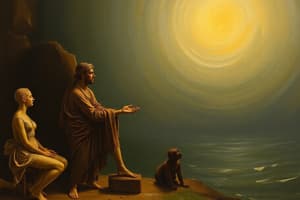Podcast
Questions and Answers
What is the primary purpose of art in human culture and history?
What is the primary purpose of art in human culture and history?
- To serve as a means of expression, communication, and record-keeping (correct)
- To serve as a tool for technological innovation
- To serve as a form of entertainment and leisure activity
- To serve as a means of generating income
During which period did the earliest known forms of art emerge?
During which period did the earliest known forms of art emerge?
- Mesolithic period
- Upper Paleolithic period (correct)
- Neolithic period
- Bronze Age
What materials were used to create early prehistoric art?
What materials were used to create early prehistoric art?
- Plastic and synthetic materials
- Clay, bone, and stone (correct)
- Metal and glass
- Wood and fabric
Which ancient civilization was known for its intricate depictions of the afterlife in art?
Which ancient civilization was known for its intricate depictions of the afterlife in art?
What was a distinctive feature of Classical Greek art?
What was a distinctive feature of Classical Greek art?
During which period did artists begin to focus on the human form, emotion, and the natural world?
During which period did artists begin to focus on the human form, emotion, and the natural world?
Which artistic movement saw a return to dramatic, expressive, and emotional styles in art?
Which artistic movement saw a return to dramatic, expressive, and emotional styles in art?
Which movement focused on emotion, individualism, and the natural beauty of the world?
Which movement focused on emotion, individualism, and the natural beauty of the world?
In which century did art experience a profound shift with the emergence of new movements and styles like abstract art and minimalism?
In which century did art experience a profound shift with the emergence of new movements and styles like abstract art and minimalism?
Which period was characterized by the dominance of Christian, Islamic, and Jewish traditions in art production?
Which period was characterized by the dominance of Christian, Islamic, and Jewish traditions in art production?
Flashcards are hidden until you start studying
Study Notes
Art's History: A Comprehensive Exploration
Art has been an essential aspect of human culture and history, serving as a means of expression, communication, and record-keeping. Throughout the centuries, various art forms and styles have emerged, reflecting the socio-economic, political, and cultural contexts of their time. This article will delve into the fascinating world of art history, exploring its development and impact on society.
Prehistoric Art
The earliest known forms of art date back to the Upper Paleolithic period, around 40,000 years ago. Cave paintings, rock engravings, and sculptures made from clay, bone, and stone were created by early humans to document their experiences, beliefs, and environment. These artworks, often depicting animals and humans, provided a means of connecting with the natural world and understanding its mysteries.
Ancient Civilizations
As human civilization evolved, so did its artistic expressions. Ancient civilizations, such as the Egyptians, Greeks, and Romans, developed their own distinctive art styles, reflecting their cultural values and technological advancements. Egyptian art, for example, was characterized by its hierarchical compositions and intricate depictions of the afterlife, while Greek art, particularly Classical Greek art, was known for its idealized human forms, naturalism, and emphasis on proportion and balance.
Middle Ages and Renaissance
During the Middle Ages, art was primarily produced for religious purposes, with Christian, Islamic, and Jewish traditions dominating the landscape. The Renaissance, which began in Italy during the 14th century, marked a shift in artistic style, as artists began to focus on the human form, emotion, and the natural world. Key figures of the Renaissance, such as Leonardo da Vinci and Michelangelo, revolutionized the way art was created and perceived, paving the way for the rapid development of new artistic styles and techniques.
Baroque and Romanticism
The Baroque period (1600-1800) saw a return to dramatic, expressive, and emotional styles in art. This movement, characterized by its use of dramatic lighting, sweeping curves, and vibrant colors, was a reaction against the simplicity and order of the Renaissance. The Romanticism movement, which emerged later, focused on emotion, individualism, and the natural beauty of the world, further broadening the scope of artistic expression.
Modern and Contemporary Art
In the 20th century, art experienced a profound shift with the emergence of new movements and styles. Abstract art, minimalism, and pop art, among others, challenged traditional notions of art and its purpose. The rise of photography and digital technology also transformed the way artists created and viewed their work, leading to new forms of artistic expression. As we continue to evolve, art will undoubtedly continue to adapt and reflect the ever-changing world in which we live.
In conclusion, art's history is a rich tapestry of diverse styles, cultures, and movements, each leaving its lasting mark on the world. By understanding the development of art throughout history, we can gain valuable insights into the human spirit and the cultural contexts that shape our artistic expressions.
Studying That Suits You
Use AI to generate personalized quizzes and flashcards to suit your learning preferences.




